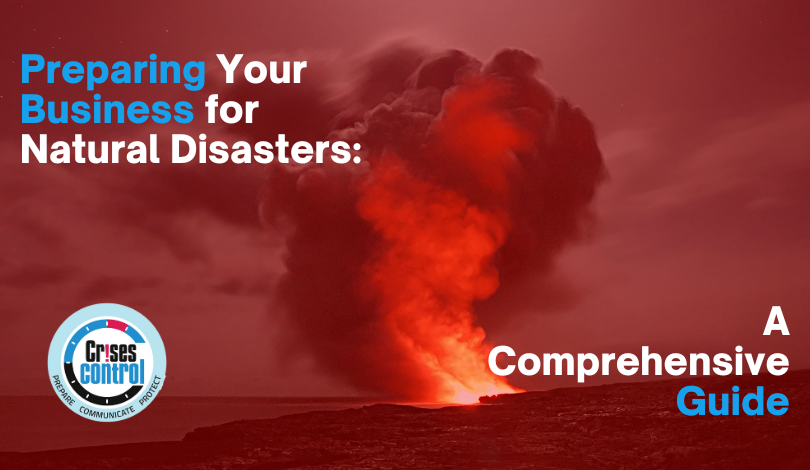At Crises Control, we understand the importance of disaster preparedness and the impact it can have on businesses. Natural disasters pose significant risks, and being well-prepared is crucial for minimising the potential damage. In this comprehensive guide, we will provide valuable insights and expert advice on how to prepare your business for natural disasters, ensuring the safety of your employees and the continuity of your operations.
Understanding the Importance of Disaster Preparedness
The Rising Threat of Natural Disasters
Natural disasters, such as hurricanes, earthquakes, floods, and wildfires, have been on the rise in recent years. These events can lead to severe disruptions in business operations, causing financial losses and jeopardising the well-being of employees. It is vital for businesses to acknowledge the increasing threat and take proactive steps to mitigate risks.
The Impact of Natural Disasters on Businesses
Natural disasters can have a devastating impact on businesses that are unprepared. The loss of infrastructure, equipment, and crucial data can cripple operations, resulting in prolonged downtime and significant financial setbacks. Moreover, businesses that fail to prioritise employee safety during such events may face legal consequences and damage to their reputation.
Assessing Risks and Developing a Plan
Conducting a Risk Assessment
Before you can develop an effective disaster preparedness plan, it is essential to assess the specific risks your business may face. Consider the geographical location, prevalent natural disasters in the area, and the vulnerabilities of your infrastructure. This assessment will help you identify the areas that require immediate attention and allocate resources accordingly.
Creating a Disaster Preparedness Plan
A well-structured disaster preparedness plan is the foundation of your business’s resilience. Here are the key steps to develop an effective plan:
Establishing Emergency Response Procedures
Outline clear procedures for employees to follow during a natural disaster. This includes evacuation routes, designated assembly areas, and communication protocols. Assign roles and responsibilities to key individuals who will oversee the execution of the plan.
Protecting Data and IT Infrastructure
Implement robust data backup and recovery systems to safeguard crucial information. Store backups in multiple locations, ideally in secure off-site facilities. Consider investing in cloud-based solutions for enhanced accessibility and redundancy.
Securing Your Physical Environment
Take preventive measures to protect your physical assets from natural disasters. This may involve reinforcing structures, installing storm shutters, or implementing fire suppression systems. Regular maintenance and inspections are vital to ensure the integrity of your facilities.
Ensuring Business Continuity
Develop a comprehensive business continuity strategy that outlines alternative operating procedures during a disaster. Identify critical functions and prioritise their restoration. Establish partnerships with alternative suppliers and service providers to mitigate disruptions in the supply chain.
Training and Education
Employee Training Programs
Educating your employees on disaster preparedness is paramount to their safety and the smooth execution of your plan. Conduct regular training sessions to familiarise employees with emergency procedures, evacuation routes, and essential safety measures. Encourage their active participation and address any concerns or questions they may have.
Simulated Disaster Drills
Organise simulated disaster drills to test the effectiveness of your preparedness plan. These drills offer an opportunity to identify areas that need improvement and ensure employees understand their roles and responsibilities. Regularly evaluate and refine your plan based on the insights gained from these drills.
Building Resilient Communication Channels
Establishing Reliable Communication Systems
During a natural disaster, maintaining effective communication is vital for coordinating response efforts. Invest in reliable communication systems that can withstand disruptions. Consider integrating mobile apps, two-way radios, and other communication tools to ensure seamless connectivity. Crises-Control offers advanced two-communication through it’s software, allowing you to alert and communicate with people instantly through SMS, voice call, video call and more.
Implementing an Emergency Notification System
Deploy an emergency notification system that enables real-time communication with employees. Crises Control provides an emergency mass notification system that can help alert people, save lives, and keep employees safe. With our system, you can send mass alerts, provide updates, and gather critical information seamlessly.
The Role of Incident Management
Integrating Workflow with an Incident Management System
An incident management system is a powerful tool that allows you to integrate your workflow, assign tasks, manage checklists, and have a plan ready and in place so it is ready to deploy in seconds should you need it. Crises Control offers an incident management system that can streamline your response efforts and ensure efficient coordination during a natural disaster.
CMT Simulations for Training and Preparedness
Crises Control also offers CMT simulations to train teams and key stakeholders. These simulations help familiarise participants with the plan and ensure they are ready to execute it smoothly should the need arise. By practising different scenarios, you can enhance your team’s preparedness and identify any gaps in your disaster response plan.
The Role of Leadership and Continuous Improvement
Leadership in Times of Crisis
Effective leadership plays a crucial role in managing natural disasters. Leaders should remain calm, make informed decisions, and communicate transparently with employees. By demonstrating strong leadership, businesses can instil confidence and ensure a smooth recovery process.
Continuously Improving the Plan
Disaster preparedness is an ongoing process. Regularly evaluate and update your plan based on the evolving risks and lessons learned from real-world incidents. Engage with employees and gather their feedback to identify areas for improvement. By continuously refining your plan, you can enhance your business’s resilience and adaptability.
Conclusion
In conclusion, prioritising disaster preparedness is essential for protecting your business, employees, and assets. By following the comprehensive guide we have provided, you can lay a strong foundation for resilience in the face of natural disasters. Remember, disasters can strike unexpectedly, so it is imperative to act now. Request a live demo or get in touch with our experts at Crises Control to learn more about how our emergency mass notification system, incident management system, and CMT simulations can help you safeguard your business and ensure continuity in the event of a disaster.








